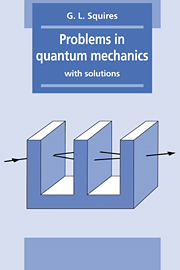Book contents
- Frontmatter
- Contents
- Acknowledgements
- Preface for the reader
- 1 Numerical values
- 2 Fundamentals
- 3 Schrödinger equation
- 4 Orbital angular momentum, hydrogen atom, harmonic oscillator
- 5 Matrices, spin, addition of angular momentum
- 6 Approximation methods. Time-independent perturbation theory, variational method
- 7 Identical particles, multielectron atoms
- 8 Time, time-dependent perturbation theory, transitions
- 9 Scattering, reactions
- 10 Miscellaneous
- References
- Index
- Frontmatter
- Contents
- Acknowledgements
- Preface for the reader
- 1 Numerical values
- 2 Fundamentals
- 3 Schrödinger equation
- 4 Orbital angular momentum, hydrogen atom, harmonic oscillator
- 5 Matrices, spin, addition of angular momentum
- 6 Approximation methods. Time-independent perturbation theory, variational method
- 7 Identical particles, multielectron atoms
- 8 Time, time-dependent perturbation theory, transitions
- 9 Scattering, reactions
- 10 Miscellaneous
- References
- Index
Summary
Summary of theory
What you need to know
Definitions and properties
Operator, linear operator, functions of operators, commuting and noncommuting operators, eigenfunction, eigenvalue, degeneracy, normalised function, orthogonal functions, Hermitian operator.
Postulates of quantum mechanics
(1) The state of a system with n position variables q1, q2, … qn is specified by a state (or wave) function ψ(q1, q2, … qn). All possible information about the system can be derived from this state function. In general, n is three times the number of particles in the system. So for a single particle n = 3, and q1, q2, q3 may be the Cartesian coordinates x, y, z, or the spherical polar coordinates r, θ, φ, or some other set of coordinates.
(2) To every observable there corresponds a Hermitian operator given by the following rules:
(i) The operator corresponding to the Cartesian position coordinate x is x × similarly for the coordinates y and z.
(ii) The operator corresponding to px, the x component of linear momentum, is (ħ/i)∂/∂x – similarly for the y and z components.
(iii) To obtain the operator corresponding to any other observable, first write down the classical expression for the observable in terms of x, y, z, px, py, pz, and then replace each of these quantities by its corresponding operator according to rules (i) and (ii).
(3) The only possible result which can be obtained when a measurement is made of an observable whose operator is A is an eigenvalue of A.
Information
- Type
- Chapter
- Information
- Problems in Quantum MechanicsWith Solutions, pp. 9 - 29Publisher: Cambridge University PressPrint publication year: 1995
Accessibility standard: Unknown
- 1
- Cited by
